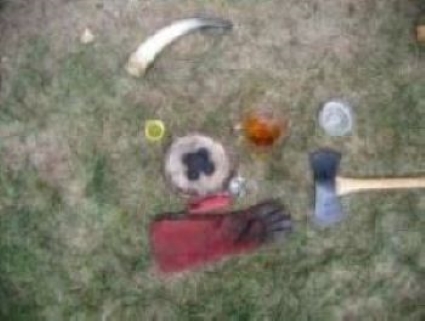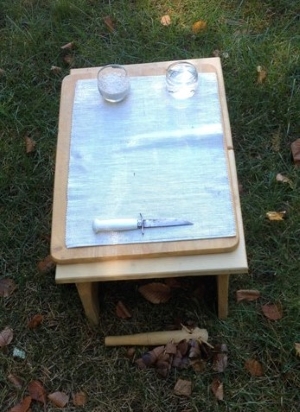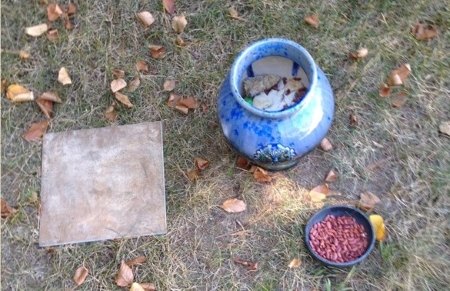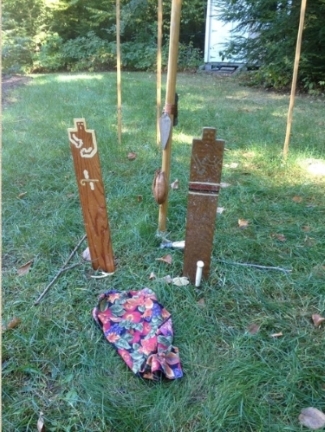These are photos of the sacred space as Nemos Ognios creates it before our rituals. (There's a video of the ritual we use to create it here.); the script for it is at here. These photos are from a fall equinox ritual, so there are things in them that are specific to that one. I'll point those out when it comes to them.

We first gather at a site some distance away from the space, and perform some rites before processing to it. We are called together, we are purified, a deity of inspiration is invoked (differing according to the ethnic tradition the ritual is in), the purpose of the ritual is stated, and, most important of all, we light our heart fire and offer to the Hearth Goddess. As the mosst important altar, the hearth will be carried to the space and used to light the altar there. In this picture you can see the cauldron with sand in it which we use for our hearth. On top of the sand are incense briquettes. Although they are self-lighting, we pour a small amount of lighter fluid on them before lighting them; you can see it in the small metal pitcher next to the cauldron. There is a small bowl of melted clarified butter which will be offered to the fire; the spoon for doing that has somehow not made it to the site for the picture. There is also a horn for calling the people together, a pitcher of mead which will be used later for a libation (the number of pitchers and what they contain vary from ritual to ritual), a bowl of water for purification, the axe which we will use to kill the sacrifice (in some rituals we use a spear, and in others a hammer), a fire lighter, and a glove made of thick leather so the Fire Tender can carry the cauldron safely. The sacrifice hasn't been brought out yet. It consists of two metal plates with a piece of pita bread between them. On the top plate is an animal made of red velvet cake, in the shape of an animal appropriate to the deity of the occasion, and frosted in an appropriate color. There are two gold chains on it, and it's then covered with a cloth napkin.

This is the space seen facing west. The gates are tall poles with grapevine wreaths, forming the druid sigil. Note that the space is rectangular, about twice as long as it is wide. There shorter poles at the corner. In the foreground you can see out Tree, representing the World Tree. Most ADFers see the World Tree as connecting the three worlds, of sea, land, and sky. We, however, see it as connecting our land to the land above. Beyond that is our altar, then the speltá, then the mundus. (There will be pictures of each of these below, with their descriptions.)

This is the top of our Tree. It's decorated with many things: feathers, stones, bags of seeds, shells, beads, shiny things, runes, and many other things. The idea is that the Tree represents the entire world.

Here's our central fire and the items around it. The fire itself is a low barbecue, so the Fire Tender can sit and reach everything around her. This also allows her to be the still center of the ritual. The photo is taken from the east, facing west, so you can see that the Fire Tender is on the south. Starting from the bottom is a cow bell that the Fire Tender uses during the sacrifice; two spoons, one for incense and one for butter; a dish with a box of matches in it in case the altar fire doesn't light easily from transferring a briquette from the hearth fire; a dish of powedered incense; a pastry brush and bowl of lighter fluid for flicking on the fire during out Waters of Life consecration; and cups, a ladle, and a silver-plated bowl for the Waters of Life. Just on the other side of the fire is the cover for the cauldron and a pitcher of water for extinguishing the fires. The bowl of dirt and the basket are there because it's the fall equinox ritual.

The speltá. It's a small table formed from a cutting board put on top of two stools. On the left are a bowl of water and one of barley flour which will be used to purify and bless the sacrifice, and on the right is a knife which will be used to cut the sacrifice up. On the ground to the right of speltá should be a pitcher with the Waters of Life in it.

This is looking down into the mundus, which is our ritual shaft. It both goes down to and comes up from the Underworld. It's the place we call the ancestors from and offer to them into. Other offerings may be put into it as well. The tile is a cover for it so as to separate the land of the dead and death itself from us when it's not necessary to have us connected with them. The bowl of kidney beans is there for offerings to the ancestors; legumes were common offerings to the dead in ancient Indo-European cultures. Note that the mundus is in the west and the tree is in the east. The west is where the sun goes down, and the east is where it rises, so there's a vertical axis that comes up from the mundus, through the fire, and then up the Tree.

These are images of two of the deities we call during our ritual. On the left is Páxusōn, our Gatekeeper in Proto-Indo-European rituals (we use other Gatekeepers in rituals in other ethnic traditions), and on the right is Xáryomēn, the Proto-Indo-European god of social unity, who's one of our grove patrons. The cloth in front of the images is the one that had covered the sacrifice. Right behind the images is the bottom of the Tree. The bag contains a snake skin and a wolf's tooth; snakes and wolfs are Outsiders, and they are kept from the rest of the Tree (and thus of the Cosmos) by the spear head. The sacrifice has taken place here, so not only is there the cloth, but the knife has been stuck into the ground.
So that what our space is like. The majority of ADF groves don't establish sacred space, but Nemos Ognios has done this from our very first ritual. We like it.
|

 Main Page
Main Page  Proto Indo-European (PIE) Religion
Proto Indo-European (PIE) Religion  Wicca
Wicca  Mithraism
Mithraism  Ritual
Ritual  Tuadem
Tuadem 
 Back to the Beginnings
Back to the Beginnings  Nuit
Nuit  Dedicant's Program
Dedicant's Program  Prayers
Prayers  Suggested Reading
Suggested Reading  Suggested Links
Suggested Links 
 Paganism
Paganism  About Me
About Me  Publications
Publications  My Calendar
My Calendar  American Paganism
American Paganism  And The Rest
And The Rest 
 Contact Me
Contact Me 









